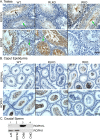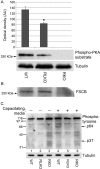Loss of R2D2 proteins ROPN1 and ROPN1L causes defects in murine sperm motility, phosphorylation, and fibrous sheath integrity
- PMID: 23303679
- PMCID: PMC4434999
- DOI: 10.1095/biolreprod.112.105262
Loss of R2D2 proteins ROPN1 and ROPN1L causes defects in murine sperm motility, phosphorylation, and fibrous sheath integrity
Abstract
The fibrous sheath (FS) is a flagellar cytoskeletal structure unique to sperm that surrounds the outer dense fibers and axoneme. Its primary components are A-kinase anchoring proteins (AKAPs) 3 and 4, which suggests that the FS affects flagellar beating via the scaffolding of signaling pathways necessary for motility. Sperm proteins ROPN1 and ROPN1L bind AKAP3. To determine the role of ROPN1 and ROPN1L in sperm function, we created mice deficient in ROPN1 (RKO), mice deficient in ROPN1L (RLKO), and double knockout mice (DKO). All three strains of mice had normal testicular morphology and spermatogenesis. Only the DKOs had obvious defects in sperm morphology (thinning and shredding of the principal piece), which was accompanied by a reduction in AKAP3 levels. RLKO mice had slightly reduced sperm motility and increased levels of ROPN1. RKO mice had moderately impaired motility and increased levels of ROPN1L. DKO sperm were immotile. We have previously determined that RKO male mice are subfertile, and DKO males are infertile. Together these data indicate that ROPN1L and ROPN1 compensate for each other in the absence of the opposing protein, possibly to maintain AKAP3 incorporation in the FS. Sperm from mice lacking ROPN1L exhibited reductions in both cAMP-dependent protein kinase (PKA) phosphorylation of a 270-kDa protein (perhaps FSCB), and in capacitation-induced tyrosine phosphorylation. Sperm from mice lacking ROPN1 had reduced levels of FSCB and increased tyrosine phosphorylation of noncapacitated sperm. These data demonstrate that mutations in ROPN1 and ROPN1L can cause defects in FS integrity, sperm motility, and PKA-dependent signaling processes, leading to male infertility.
Figures




Similar articles
-
FSCB phosphorylation regulates mouse spermatozoa capacitation through suppressing SUMOylation of ROPN1/ROPN1L.Am J Transl Res. 2016 Jun 15;8(6):2776-82. eCollection 2016. Am J Transl Res. 2016. PMID: 27398160 Free PMC article.
-
Loss of ASP but not ROPN1 reduces mammalian ciliary motility.Cytoskeleton (Hoboken). 2012 Jan;69(1):22-32. doi: 10.1002/cm.20539. Epub 2011 Nov 8. Cytoskeleton (Hoboken). 2012. PMID: 22021175 Free PMC article.
-
AKAP3-mediated type I PKA signaling is required for mouse sperm hyperactivation and fertility†.Biol Reprod. 2024 Apr 11;110(4):684-697. doi: 10.1093/biolre/ioad180. Biol Reprod. 2024. PMID: 38145487
-
The role of A-kinase anchoring proteins (AKaps) in regulating sperm function.Soc Reprod Fertil Suppl. 2007;63:135-41. Soc Reprod Fertil Suppl. 2007. PMID: 17566268 Review.
-
Formation and function of sperm tail structures in association with sperm motility defects.Biol Reprod. 2017 Oct 1;97(4):522-536. doi: 10.1093/biolre/iox096. Biol Reprod. 2017. PMID: 29024992 Review.
Cited by
-
Bull Sperm Capacitation Is Accompanied by Redox Modifications of Proteins.Int J Mol Sci. 2021 Jul 23;22(15):7903. doi: 10.3390/ijms22157903. Int J Mol Sci. 2021. PMID: 34360666 Free PMC article.
-
Transketolase-like 1 ectopic expression is associated with DNA hypomethylation and induces the Warburg effect in melanoma cells.BMC Cancer. 2016 Feb 22;16:134. doi: 10.1186/s12885-016-2185-5. BMC Cancer. 2016. PMID: 26907172 Free PMC article.
-
Studies in experimental autoimmune encephalomyelitis do not support developmental bisphenol a exposure as an environmental factor in increasing multiple sclerosis risk.Toxicol Sci. 2013 Sep;135(1):91-102. doi: 10.1093/toxsci/kft141. Epub 2013 Jun 23. Toxicol Sci. 2013. PMID: 23798566 Free PMC article.
-
Identification of candidate proteins influencing spermatogenesis in Shandong black cattle via integrated multiomics analysis.BMC Genomics. 2025 Jul 1;26(1):628. doi: 10.1186/s12864-025-11825-1. BMC Genomics. 2025. PMID: 40596853 Free PMC article.
-
Comparative Proteomics and Phosphoproteomics Analysis Reveal the Possible Breed Difference in Yorkshire and Duroc Boar Spermatozoa.Front Cell Dev Biol. 2021 Jul 16;9:652809. doi: 10.3389/fcell.2021.652809. eCollection 2021. Front Cell Dev Biol. 2021. PMID: 34336820 Free PMC article.
References
-
- Remenyi A, Good MC, Lim WA. Docking interactions in protein kinase and phosphatase networks. Curr Opin Struct Biol 2006; 16: 676 685. - PubMed
-
- Carr DW, Stofko-Hahn RE, Fraser ID, Bishop SM, Acott TS, Brennan RG, Scott JD. Interaction of the regulatory subunit (RII) of cAMP-dependent protein kinase with RII-anchoring proteins occurs through an amphipathic helix binding motif. J Biol Chem 1991; 266: 14188 14192. - PubMed
-
- Bhattacharyya RP, Remenyi A, Yeh BJ, Lim WA. Domains, motifs, and scaffolds: the role of modular interactions in the evolution and wiring of cell signaling circuits. Annu Rev Biochem 2006; 75: 655 680. - PubMed
-
- Carr DW, Fujita A, Stentz CL, Liberty GA, Olson GE, Narumiya S. Identification of sperm-specific proteins that interact with A-kinase anchoring proteins in a manner similar to the type II regulatory subunit of PKA. J Biol Chem 2001; 276: 17332 17338. - PubMed
-
- Eddy EM, Toshimori K, O'Brien DA. Fibrous sheath of mammalian spermatozoa. Microsc Res Tech 2003; 61: 103 115. - PubMed
Publication types
MeSH terms
Substances
Grants and funding
LinkOut - more resources
Full Text Sources
Other Literature Sources
Molecular Biology Databases

